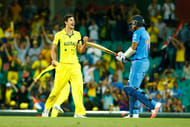As the ICC World Cup 2015 enters its climax, one thing that stands out amid all the heroics is the format of the tournament. Unlike the 1999, 2003 and 2007 World Cups that had Super Six and Super Eight formats, the present World Cup has retained the format of the 2011 World Cup.
Positives of the format
All the talk of the next World Cup being a 10-country tournament brings us to the question: Is it important to include the so-called minnows in the World Cup? Or preserve the competitiveness of the premier cricket tournament by restricting entry to the Test playing nations only?
From all what we have seen across different World Cups, these teams play each other in the qualifying tournament which brings out the best teams that have progressed in their cricket in the last 4 years. These teams on their day have the capability to surprise any big team. This was also evident in this World Cup where some of the matches of these teams were more interesting and closer than the ones played between the more revered teams.
The presence of these teams enables a system where every 4 years there are a few sides who get the chance to showcase their developed capabilities and challenge the top teams in the world. If even this chance is taken away from them, their cricket is sure to die a slow but certain death.
Cricket still is a game played by a handful of teams across the world, unlike football whose footprint is worldwide. The World Cup being the most viewed and followed tournament is the biggest tool for spreading the game in other parts of the world.
This format has ensured that the teams playing top-class cricket in the last four years (2011-2015) made it to the knockouts. The statistics, given below, highlight the fact.
| Team | ODIs Played | Won | Lost | Winning Percentage |
|---|---|---|---|---|
| India | 109 | 66 | 34 | 60.55 |
| South Africa | 77 | 44 | 29 | 57.14 |
| Australia | 90 | 53 | 29 | 58.88 |
| New Zealand | 71 | 36 | 29 | 50.70 |
| Pakistan | 96 | 48 | 45 | 50 |
| West Indies | 84 | 35 | 46 | 41.66 |
| Sri Lanka | 128 | 62 | 59 | 48.43 |
| Bangladesh | 56 | 21 | 33 | 37.5 |
Source: www.espncricinfo.com
The top four make the last four
While some may say that England should have qualified for the knockouts instead of Bangladesh, the fact that the Englishmen failed to keep key players like Kevin Pietersen, Jonathan Trott and Alastair Cook hurt their chances. They are big match players and can win matches from tough situations. The Bangladeshi team gained a lot of confidence and exposure from the Bangladesh Premier League (BPL) and it helped them topple England in a crunch game.
The top four as seen in the table unsurprisingly proceeded to the semi-finals. Although India and South Africa would think they missed out on a final berth, from the semi-finals onwards, it’s the team which ups its game on the day and holds its nerve in crunch situations that wins.
Thus, we would witness the first trans-Tasman final on Sunday, the 29th of March, 2015. Interestingly, it was this day 69 years ago in 1946 that these very teams played the first ever Test match between themselves. Then, Australia beat New Zealand in two days, but times have changed and so have the New Zealand team. In fact, the Blackcaps are, according to some, the favourites to lift their first ever World Cup title.
Follow IPL Auction 2025 Live Updates, News & Biddings at Sportskeeda. Get the fastest updates on Mega-Auction and cricket news

